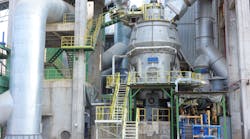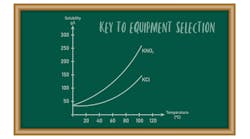Solids Processing: Unleashing Innovative Strategies Beyond the Norm
We’ve all heard the expression, “think outside the box.” Solid processing is clearly an area where this is an appropriate strategy. Particulate solids don’t play by the rules — and many of the rules we use to evaluate their behavior have exceptions. One of my favorites has to do with long-radius elbows. It assumes that the solids flow along the elbow in such a manner that friction is reduced. To some extent, that is correct if the particles knew they were supposed to slow down and not run into each other. The rule works when the velocity is low for a given particle strength. But even then, the elbow may suffer.
More often, the particles slam into one side of the elbow and bounce over to the other side. After repeated blows, the wall fails. Note that I’m not saying long-radius elbows will always fail, but that, given the right circumstances, they could fail. And when they do fail, it is an expensive repair. The weight and size of the elbow precludes a one-person job. This rule probably originated from experience with very low solids-to-air ratios and dilute-phase conveying systems, so particle-particle impact was minimal. As an aside, the reason for low solids-to-air ratios for materials like grain was to prevent pluggages due to rats, another good reason to think outside the box.
Process design is usually a straightforward extension of laboratory work and often small-scale pilot tests. However, getting a product to market or responding to a critical situation may require an unusual approach. I’ve been involved in many designs where all conventional processes either had a high technical or financial risk. In corporate jargon, “We can afford failures, but not below the waterline of the ship.”
We had a process that required a very low particulate emission rate. All the conventional designs would wipe out profits for many years — unacceptable! I proposed using three well-established technologies connected in a different manner. Each one could be proven with a minimal amount of research, which was critical because we had less than a year to select the parameters for each device and build the full-scale unit. The key “outside the box” item was using a little-known phenomenon of reverse-flow cyclones to carry out a chemical reaction.
This case illustrates what I like to call “thinking outside the solids processing box.” This method utilizes an understanding of several fundamentals of particulate solids and can point the way to discovering why solids don’t always follow the rules we expect. Here are my top five properties to keep in mind when looking for alternate processing routes:
- Particulate solids are two-phase mixtures. You can change the way solids respond to external forces such as pressure or temperature. When the second phase is gas, the mixture is compressible, and the volume of the mixture is controlled by the gas. Take advantage of this difference, especially when particles are different shapes.
- Solids have electrical properties. The conductivity of the solid may vary from the surface throughout the solid. This can hold or repel particles and change the apparent density of the particle mixture. Fine particles can pick up a charge when flowing over conductive surfaces, but this becomes less important as physical size increases.
- Solids have mechanical properties. You can break particles using stress or abrasion, giving the mixture an additional phase to deal with. These two mechanisms can control the final particle size distribution and interact with the previous properties to further alter the mixtures’ behavior.
- Particle size adds complexity to the solid phase. Particles may act individually or in combination. The preceding properties can alter the apparent size (think settling or reaction rate).
- Solids can contain different chemical compounds. The chemical species can be different, not only in the overall mixture but within individual particles. The result is different mechanical and electrical characteristics.
If you’re looking to find a new product or develop a better process, particulate solids are the best candidates for thinking outside the box because of the many properties that can be manipulated. No wonder we find this technology area so fascinating — and frustrating



